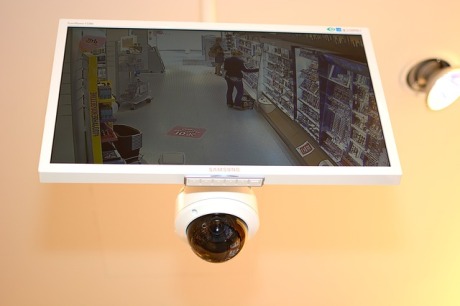In this ongoing series we look at ways of preventing employee theft. In part one we looked a cash handling methods, in part two we looked at credit card theft, in this part we take a look at best practices for preventing theft from inventory, and in part four we look at time theft.
As with credit cards, and particularly cash, inventory control and theft prevention are a matter of sensible precautions, double checking, and never allowing any one person too much control. Video cameras are also a prerequisite for any kind of inventory theft protection. The deterrent factor alone makes them a worthy investment. It is important to consider placement with video cameras, however, and to consider this when placing items in storage that are more likely to be stolen.

Image courtesy of Pixabay
Risks
Identifying the high-risk items that desirable to a thief is an important first step in any prevention strategy. What makes items desirable to a thief? High value, small size, and / or easy to sell or use themselves. In a veterinary practice, controlled substances would be at the top of this list for obvious reasons, but pet food and treats would also make the list as they are routine supplies for any pet owner. Any establishment that sells alcoholic beverages, needs to consider just how easy, and desirable, it is to steal them – particularly hard liquor. It is informative to walk around your local grocery store and check out the different levels of security in different items and then apply those to your own business. Alcohol, of course, has additional measures in place in a grocery store, but so do razor blades (due to their expense and small size) and movies (due to their small size and ease of resale.) High risk high value items should have significantly higher levels of security and scrutiny than other items. That means that only key people will have access. This will make things more complicated for their handling, but the alternative is no security at all.
Certain items are always at risk of theft due to their ubiquitous nature: toilet paper, stationary, and cleaning supplies. Keeping an eye on reorder quantities is really the only way to ensure that a problem with theft is not missed; however, just watching the cameras on the employee entrance/ exit can often be enough.
Businesses that have significant issues with employee theft, will often ask to look in employee bags before as they leave the premises. While this can seem overly intrusive, it is important that your employee handbook contains language to make this a possibility if required.

Image courtesy of Pixabay
Ordering & Receiving
Ordering in any business needs to be controlled. The person that is responsible for ordering, should not be the same person who is responsible to receiving goods and ensuring that what was ordered has indeed arrived. In addition to having multiple people involved, there also has to be a paper trail. When an item is ordered, the order has to be logged through a purchase order record of some description. When the item arrives, it should be received by someone other than the person who ordered it, the packing slip should be signed off on (or a packing slip created if the goods did not come with one) and then forwarded to accounts payable.
The packing slip should be matched to the purchase order which it turn is then matched to invoice. When things are paid for by credit card, it should be indicated on the purchase order, and then the credit card bill should be reconciled against packing slips and purchase orders.
The above may seem over the top for most small businesses, but the question that has to be answered is what is to stop an employee ordering an item from a supplier, destroying any paperwork, and taking the item home? Is your accounts payable person, assuming that they are not the same person who has been ordering, going to be able to find that one uncounted for item in amongst everything that is ordered when a supplier’s statement comes in weeks later?
On a side note, it should be made abundantly clear to all involved with ordering and receiving that “free product” or “gifts” from suppliers belong to the business, not to whomever receives them. There is sometimes the impression that because items have not been ordered, or have been nominally given a $0.00 value, that they are free to anyone who wants them. This cannot be the culture in your business.
Items which arrive outside the hours when they can be received properly, and by the appropriate members of staff, should be locked away unless there are serious reasons why they should not be (items that need to be refrigerated for example.) This prevents well intentioned, but misguided attempts to “help” and also more nefarious outcomes. It also prevents the frustration of knowing that an item is in the building but being unable to find it due to it being put away somewhere other than where it should be.

Image courtesy of Pixabay
Stock
In order to sell products, employees need to have access to those products. That does not mean; however, that all employees need access to all products, at all times. A limited amount of non-high risk non-high value items should be placed on employee accessible shelves. Your main stock should be under lock, key, and camera. The inventory manager, or a supervisor, should be the only one who moves stock from one location to another. For high-risk high-value items, senior members of staff should be the only persons who can have access, and they themselves should have a strict protocol (a log book at minimum) which they have to follow when retrieving an item.

Image courtesy of Pixabay
Counting
Inventory has to be tracked. If you order 10 widgets and have 5 widgets in stock your inventory system should be able to tell you that after you have received your new widgets that, yes you can fill that order for 15 widgets.
The reality, of course, is rarely that simple. When it comes to inventory control you get out what you are prepared to put into it. An accurate inventory management system, where you can spot that five items are missing almost as soon as they are gone, only happens through hard work and effort. Good systems that are easy to use will work well, but they have to be maintained and repaired. Not just so that the system is correct, but so that the faith of employees, and managers, in the system is maintained.
High risk items should be counted once or twice a week. Discrepancies should be resolved or reported. All inventory items should be counted once or twice a year and the running count in the inventory control system reset. Constant shortages should be investigated as to whether it is shrinkage (theft), orders in process, or the mis-selling of items.
This level of effort put into inventory control can seem expensive and wasteful; however, you cannot track what you do not count. And you cannot know what is going on with inventory unless you count it.

Image courtesy of Pixabay
Auditing
In addition to counting, there is another way to see if items are walking out of your premises and not being accounted for. At the beginning of the year you bought 100 fidget spinners. You look up the invoice from Fidget Spinner Inc. and confirm that you were billed and paid for 100 units. At the end of the year you have 10 fidget spinners on the shelf. You run a report from your sales software on how many fidget spinners you have sold. Hopefully, it says you have sold 90. But what if it says you sold 80?
The inventory control side of things says that there should only be 10 in stock, which there are, but you have not sold 90. The problem could have been in the number that were received originally from the supplier, or whomever received them, or someone with access to the inventory control system has manipulated the system to make it appear that 10 fidget spinners are not missing.
You’ll notice in the above example, that it does not rely on inventory management to find that there is a problem; but it does allow for the problem to be narrowed down. This can really only ever be used for spot checking, but it does provide a backup system to the general inventory control system.

Image courtesy of Pixabay
Employee Sales
Sales of items to employees can be tricky to navigate from a theft prevention standpoint. An employee leaving the building with a bag of dog food from the vet’s office looks identical to an employee stealing a bag of dog food from the vet’s office. Having a strict protocol in place for sales of items to employees so that all items can be accounted for is essential. Do not allow employees to process their own transactions; there is just too much opportunity for issues to arise. All items should be billed for at full price and then a senior member of management should handle any discounts.
Inventory can be difficult at the best of times. Employee shrinkage; however, can be a serious problem and significant inventory controls will not only serve the needs of the business, but protect it from those should have its interests at heart.

[…] we look at ways of preventing employee theft. In part one we looked a cash handling methods, and in part three we look at inventory theft. In this part we take a look at best practices for preventing theft with Credit […]
[…] In this ongoing series we look at ways of preventing employee theft. In this part we take a look at best practices for preventing theft when working with cash. In part two, we look at how to prevent Credit Card theft from the business and customers. In part three, we look at inventory theft. […]
[…] In part one we looked a cash handling methods, in part two we looked at credit card theft, in part three we looked look at best practices for preventing theft from inventory, and this week we look at time […]
[…] In part one we looked a cash handling methods, in part two we looked at credit card theft, in part three we looked look at best practices for preventing theft from inventory, and in part four we looked at employee time […]